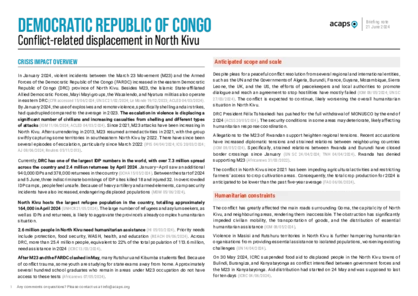Latest updates on country situation
06 October 2025
Worsening health conditions are compounding humanitarian needs in the Democratic Republic of Congo. There is an active cholera outbreak across 17 provinces, with over 41,000 suspected cases and nearly 1,500 deaths since January 2025. After a confirmed death, the Ministry of Health also declared an Ebola outbreak in Kasaï Central on 3 October. Mpox cases also continue to rise, with more than 3,000 suspected cases this year. Displacement, poor WASH infrastructure, and limited access to healthcare are accelerating the spread of disease. (WHO 03/10/2025, Mercy Corps 02/10/2025, WFP 26/09/2025)
08 September 2025
Health authorities have declared a new Ebola virus disease outbreak in Kasaï province, with 28 suspected cases and 16 deaths, including four health workers, by 5 September 2025. The outbreak centres are in remote areas with poor access and weak infrastructure, complicating containment. While the Democratic Republic of Congo has experience controlling past outbreaks, the risk of undetected transmission remains high. (WHO 05/09/2025, IOM 05/09/2025, IMC 04/09/2025)
15 July 2025
A cholera outbreak in the Democratic Republic of Congo has intensified, with nearly 33,000 cases and over 700 deaths reported by July since January 2025. The northeastern province of Tshopo is the most affected, while Kinshasa’s health zones are experiencing weekly surges linked to poor hygiene and recent floods. (RFI 11/07/2025, DW 10/07/2025, WHO 17/06/2025)
15 July 2025
Armed violence continues to escalate in eastern DRC, driving displacement and worsening humanitarian access. In Ituri, the Allied Democratic Forces – a non-state armed group – killed at least 66 civilians in Irumu territory between 9–12 July. This comes after a surge of attacks in June, which caused over 9,000 people to flee their homes in Djugu. In South Kivu, clashes between the March 23 Movement and Congolese army forces, supported by allied fighters, opened a new front of hostilities near the town of Uvira, displacing 40,000 people in the surrounding Uvira territory. In North Kivu province, civilians face growing protection risks, including arbitrary arrests by state forces, forced recruitment by non-state armed groups, and having to carry supplies such as food and ammunition for these groups. These abuses are particularly common in the territories of Lubero, Masisi, and Walikale. Armed group activities and insecurity continue to restrict humanitarian access and increase humanitarian needs.(OCHA 15/07/2025, DW 11/07/2025, RFI 15/07/2025)
17 June 2025
On 14 June 2025, exceptional rainfall caused severe flooding in Kinshasa, killing at least 30 people and injuring 44 by 16 June. The floods displaced over 36,000 people and affected around 70,000. In Matete commune alone, more than 500 homes were inundated. The most urgent needs of those affected include food, NFIs, and emergency shelter. (ECHO 16/06/2025, RFI 15/06/2025, Radio Okapi 16/06/2025)
09 June 2025
Health conditions have deteriorated across the Democratic Republic of Congo in 2025. Fighting since early January has damaged health infrastructure and displaced thousands, straining access to essential services. Over 1.15 million people have been displaced in Nord and Sud Kivu provinces, where conflict persists. Displacements stress the capacity of host communities and health infrastructure. In April, severe floods in Kinshasa affected 13 of the capital’s 24 municipalities, damaging over 9,000 homes and displacing over 7,000 people. As a result, stagnant water, contaminated latrines, and damaged water infrastructure have heightened the risk of cholera, malaria, and typhoid, particularly in overcrowded shelters. By May, over 18,000 cholera cases and 364 related deaths had been reported nationwide. The situation is expected to worsen as temperatures rise between June–August, coupled with limited access to clean water, sanitation, and healthcare. (UNICEF 04/06/2025, UNHCR 30/05/2025, WVI 23/05/2025, NRC 02/04/2025)
27 May 2025
Acute food insecurity is worsening in the Democratic Republic of the Congo. By May 2025, nearly 28 million people were facing acute food insecurity – i.e. Crisis (IPC Phase 3) or worse conditions, including 3.9 million in Emergency (IPC Phase 4) levels. Conflict, mass displacement, and funding cuts are driving the crisis, particularly in Ituri, North and South Kivu, and Tanganyika provinces. (WFP 23/05/2025, AAH 29/04/2025, UN 27/03/2025)
current crises
in
DRC
These crises have been identified through the INFORM Severity Index, a tool for measuring and comparing the severity of humanitarian crises globally.
COD001 - Complex crisis
Last updated 26/09/2025
Drivers
Conflict/ Violence
Floods
Political/economic crisis
Crisis level
Country
Severity level
4.5 Very High
Access constraints
4.0
Active risks
Analysis products
on
DRC
06 August 2025
DRC: cholera outbreak in the Eastern provinces
DOCUMENT / PDF / 333 KB
This report seeks to provide an analysis of the recent increase in cholera cases in the DRC. The current outbreak affects both eastern and western provinces. By July 2025, the outbreak had severely affected Kinshasa and nearby provinces, which were particularly hard hit by flooding.
13 March 2025
DRC: Anticipated implications of US stop-work orders and subsequent cuts
DOCUMENT / PDF / 1,014 KB
This report analyses the current and potential implications of the US SWOs, subsequent cuts on humanitarian operations, and needs in the DRC, with a focus on the escalating humanitarian needs in eastern DRC provinces as conflict persists.
Attached resources
05 February 2025
DRC: Conflict escalation in Goma (North Kivu)
DOCUMENT / PDF / 489 KB
Since the beginning of 2025, conflict in eastern Democratic Republic of Congo (DRC) has escalated significantly, with the March 23 Movement (M23) non-state armed group and allied Rwandan forces entering Goma, the capital of North Kivu, on 26 January.
19 December 2024
DRC: conflict across the west
DOCUMENT / PDF / 640 KB
The conflict in Kwamouth territory, Mai-Ndombe province, in the western DRC erupted in June 2022 because of a longstanding dispute between the Teke and Yaka communities over land rights and customary fees. Factors such as increasing population pressure, resource scarcity, and political manipulation have aggravated conflict between the two communities. As of 24 October 2024, 146,000 people have been displaced.
Attached resources
21 June 2024
Democratic Republic of Congo: conflict-related displacement in North Kivu
DOCUMENT / PDF / 1 MB
In January 2024, violent incidents between the March 23 Movement (M23) and the Armed Forces of the Democratic Republic of the Congo (FARDC) increased in the eastern Democratic Republic of Congo (DRC) province of North Kivu.






